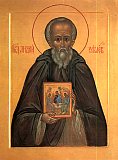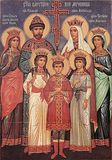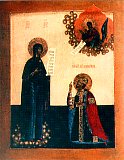

| Previous day | Next day |
| Old Style
July 4
|
Monday |
New Style
July 17
|
| 7th Week after Pentecost. Tone 5. | No fast.
|
![]() St. Andrew, archbishop of Crete (740).
St. Andrew, archbishop of Crete (740). ![]() St. Martha, mother of St. Symeon Stylites (the Younger), of the Wonderful Mountain (551).
St. Martha, mother of St. Symeon Stylites (the Younger), of the Wonderful Mountain (551). ![]() St. Andrew (Rublev), iconographer, of the Spaso-Andronikov Monastery (Moscow) (15th c.).
St. Andrew (Rublev), iconographer, of the Spaso-Andronikov Monastery (Moscow) (15th c.). ![]() Holy Royal Martyrs of Russia: Tsar Nicholas II, Tsaritsa Alexandra, Crown Prince Alexis, and Grand Duchesses Olga, Tatiana, Maria, and Anastasia and with them New Martyr Eugene Botkin, physician (1918).
Holy Royal Martyrs of Russia: Tsar Nicholas II, Tsaritsa Alexandra, Crown Prince Alexis, and Grand Duchesses Olga, Tatiana, Maria, and Anastasia and with them New Martyr Eugene Botkin, physician (1918).
Martyrs Theodotus and Theodota, martyred with St. Hyacinth at Caesarea in Cappadocia (108). Hieromartyr Theodore, bishop of Cyrene in Libya, and with him Martyrs Cyprilla, Aroa, and Lucia (310). Burial of St. Andrew, prince of Bogoliubovo (1174). Uncovering of the relics of St. Euthymius the Wonderworker, archimandrite, of Suzdal (1507). St. Andrew the Russian, confessor, in Cairo (ca. 1850). New Hieromartyrs Sava, bishop of Gornji Karlovac (1941) and George Bogich, priest, of Nasice (1941).
New Hieromartyr Nilus, hieromonk, of Poltava (1918).
Hieromartyrs Innocent and Sabbatius, and 30 others with them, in Sirmium of Pannonia (304). Translation of the relics of St. Martin the Merciful, bishop of Tours (460-490). St. Ulrich of Augsburg and Bavaria (973). St. Michael Choniates, metropolitan of Athens (1222). Hieromartyr Donatus, bishop of Libya.
Repose of Hieroschemamonk John, founder of Sarov Monastery (1737), and Archpriest Tikhon Pelikh of Sergiev Posad (1983). Slaying of General Dragoljub (Drazha) Mihailovic of Serbia (1946).
Thoughts for Each Day of the Year
According to the Daily Church Readings from the Word of God
By St. Theophan the Recluse

Monday. [I Cor. 5:9-6:11; Matt. 13:54-58]
The Nazarenes did not believe the word of the Lord, because when He lived in amongst them, He had no attractive lustre or outward dignity that would command involuntary respect from all. “We know who He is,” they said; “there can’t be anything extraordinary about Him.” Their reaction, however, did not induce the Lord to assume an imposing appearance. He remained extremely simple in appearance; later the Apostles bore themselves the same way, as did all of those who truly followed and emulated them. Why is this so? Because it is there is no man-made lustre that could fully correspond to the light of life in Jesus Christ. Moreover, we recognize that it is better to relegate external appearance the lowest value, so that it does not block what is within. Let him who has eyes to see look directly at the latter, without arresting his attention upon the former. The holy Apostle Paul expressed it like this: We have this treasure in earthen vessels (II Cor. 4:7). If we could see what was the outward appearance of those persons whom we now revere and call upon in prayer, we would not believe our eyes—they were so simple. But to this day, those who have come to know the life in Jesus Christ abandon care for their outward appearance and turn fully within. That is why the former falls away on its own, but the latter is raised up and grows. It often happens that nobody even notices this inner brightness, not even the one who possesses it. The human eye is evil; it is not shown what is truly good, if this good can harm it.
Articles
 St Andrew the Archbishop of CreteSaint Andrew, Archbishop of Crete, was born in the city of Damascus into a pious Christian family. Up until seven years of age the boy was mute and did not talk. |
 The Holy Royal MartyrsMetropolitan Tikhon (Shevkunov) of Pskov and Porkhov |
 Hieromartyr Theodore, bishop of Cyrene in Libya, and with him Martyrs Cyprilla, Aroa, and LuciaThe Hieromartyr Theodore, Bishop of Cyrene, lived during the reign of the emperor Diocletian (284-305). |





